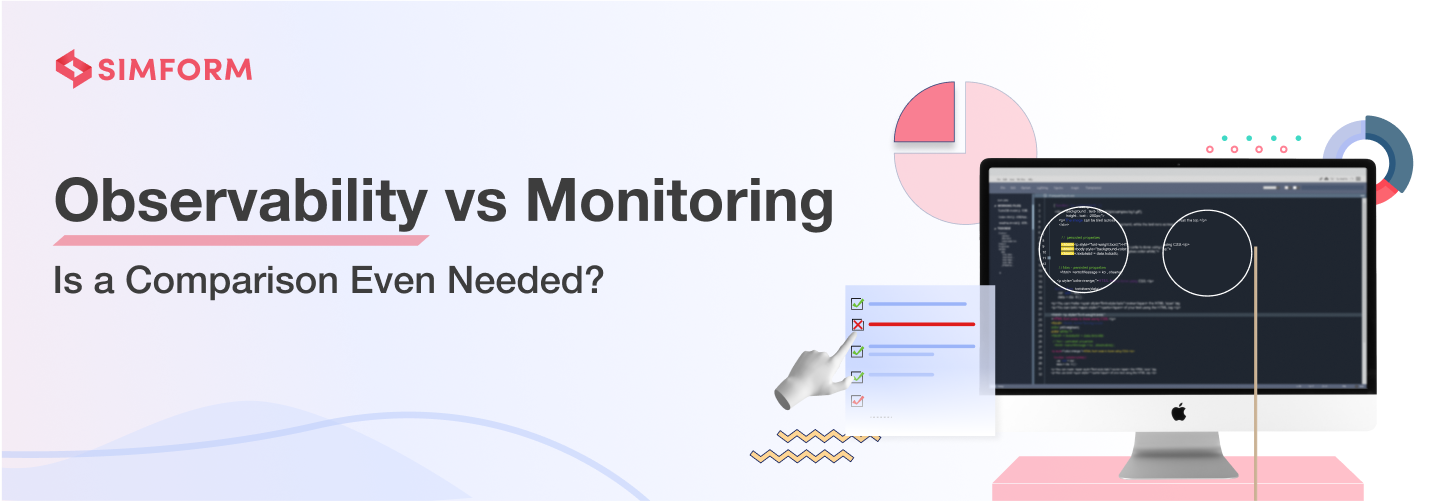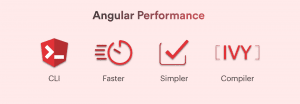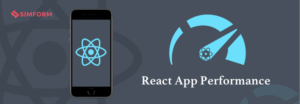Observability vs. Monitoring: Similarities, Differences, and Use Cases
Observability vs. monitoring?
Is that a question you should ask? No.
Ever since applications were first deployed, systems were put in place to ensure optimal performance. Legacy applications used to be made up of fewer elements, and monitoring was sufficient for them. But modern applications gave birth to modern requirements, and thus observability came into the picture.
This article will take you through the similarities and differences in observability and monitoring. We’ll also tell you why the shift from monitoring to observability is precisely what’s needed for modern systems. And then, we’ll also take you through the use cases of both observability and monitoring.
What is monitoring?
It is the collection and analysis of system data to ensure things are working as expected. The predefined parameters measured under monitoring give you a peek into the predictable mode of failures of the system. You can set up dashboards and alerting mechanisms to know when output from any monitored components isn’t optimum. And subsequently, take action to address the issues.
Monitoring also helps identify long-term trends through data and assess if you are true to the business objectives. Monitoring applies to both macro and microscopic levels of the system. So based on whether you are monitoring a CI/CD pipeline or the entire infrastructure, you track parameters like
- deployment frequency,
- deployment failure,
- mean time to detect errors,
- CPU utilization,
- memory use,
- resource usage,
and so on.
But monitoring alone isn’t enough
While monitoring is an effective way to know what’s broken, it rarely tells you why it is broken. With systems getting increasingly complex, it has become difficult to address the reason for failures and, therefore, address it.
A deeper understanding of the system and its flows is needed to understand the reasons behind faults in complex systems. Which is why a move from monitoring to observability started.
What is observability?
Observability is the ability to deduce the inner state of the system by collecting and analyzing its outputs. While it sounds similar to traditional monitoring, observability is a superset of monitoring as it also focuses on unknown unknowns. These are the unpredictable ways a complex system, with many intertwined components, can fail. And it isn’t something unheard of in distributed systems.
Observability answers various questions like:
- What went wrong with X?
- Why has performance degraded over the past few weeks?
- Where should you look to resolve the issue?
- What was your system’s state on a particular date and time?
- Did you violate an SLO?
- What SLOs should you have?
To make a system observable, you use tooling to collect telemetry data in the form of logs, metrics, and traces— the three pillars of observability. The information then enables SREs to understand what’s not working, why it’s not working, and how to fix it.
Three pillars of observability
Logs are textual records with relevant information for all the events in an application. They come in three formats: plain text, structured, and binary. Logs are distinct, immutable, and contain time-stamped information that helps SREs understand the context. Structured logs store additional metadata, which lends a deeper dive into every issue. Storing logs, however, can be an expensive affair.
Metrics are numerical values usually measured over a period of time to quantify the performance of various system elements like infrastructure, cloud platforms, services, etc. They are used to monitor a wide range of attributes such as memory usage, CPU capacity, latency rates, etc.
Traces help monitor how a single transaction request flows through the application. It’s a critical element of observable systems since it usually helps bring everything into context. Instead of looking at multiple data streams, traces allow you to look at a single data stream of the transaction to get to the root cause of the issue and fix it.
Observability and monitoring have more similarities than differences. And therefore, it doesn’t make much sense to simply compare the two. Instead, it would help if you understand the evolution journey from monitoring to observability.
Monitoring to observability, not monitoring vs. observability
Monitoring was enough for legacy systems
Traditional IT infrastructures were composed of fewer and simpler elements. It was relatively easier to predict what could go wrong. And you could detect if something was wrong by looking at a select few parameters.
Similarly, it was easier to establish correlations between components and get to the root cause of the issue when needed. Again, this was possible because there were fewer components, which means fewer possible connections between the components.
Monitoring solutions were enough to ensure the optimal performance of such systems.
Modern systems need to be observable
But modern infrastructures have exponentially more components with microservices, containers, and other instances. A lot of data is generated as outputs at any given point. On top of that, many more connections between components make it extremely difficult to get to the root cause of the issues.
Earlier, SREs would collect, correlate, clean, and analyze the logs and metrics data. But with the increased number of components, they could no longer remain effective in working the same way.
Distributed tracing to establish correlations
The next evolutionary stage brought distributed tracing into the mix. It meant stamping IDs on every event and operation. Tracing made it possible to track an operation’s logs across components using the relevant ID.
Based on the situation, you can assign more attributes to events and have IDs to track them. While distributed tracing sounds like a simple solution to manage distributed systems, it’s very difficult to implement it across the system.
Common language for easier interpretation of information
Another major change brought about by the observability solution is the adoption of a common language to describe systems.
With individual systems using varying schema to denote similar events, it was challenging to interpret data effectively across systems. For example, HTTP => 500, http_code => 500 Internal Error, and httpStatus => 5xx are all different ways to denote the same event.
Automated analysis of data might not be able to draw relations between the three. And it would take longer to resolve the issue. Observability aims to establish common formatting for standard values. Doing so opens up room for more automated data analysis and, therefore, faster and more efficient issue resolution.
Unified tooling to generate a single data stream
Finally, observability also brings more sanity to distributed systems by unifying tooling used to collect data. If each tool creates its own data stream, it’ll always take time to get to the root cause.
Modern observability solutions have brought the tools under the same umbrella such that all of them serve a singular purpose to SREs.
Similarities between Observability vs. Monitoring
While the goal of observability and monitoring are essentially the same, there are distinct characteristics that differentiate the two. Let’s explore the similarities and differences between the two.
They help fix issues: Both observability and monitoring help keep the system working and reliable by identifying and resolving issues.
They rely on data: Another common feature is that both leverage data to pinpoint the issue. When you dive deeper into both these areas, differences start to emerge.
Demand a deeper understanding of the system: Also, irrespective of whether you try to implement observability or monitoring, a holistic understanding of the system is necessary. Especially in the case of monitoring because, unlike observability, it doesn’t help you establish connections between various events in the system.
Difference between Observability vs. Monitoring
Predetermined vs. unknown: One of the bigger differences between observability and monitoring lies in the kind of data they collect. In the case of monitoring, you deal with dashboards in which the team keeps track of metrics they think are critical. But what if something goes wrong that isn’t being monitored through the dashboard?
Observability collects data from the entire system and then drills down to the issue. So if something goes wrong, it’d correlate data from the whole system to determine the root cause of the problem.
Reactive vs. preemptive: Monitoring focuses on specific system outputs and notifies you only when the numbers cross the acceptable range. SREs then react to these notifications and figure out what went wrong.
With observability, you don’t need to wait for the system to fail before you encounter the issues. Observability lets you act preemptively with data collected from all across the system. And SREs can start working even when a negative trend shows up. Observability enables you to connect the dots and address the underlying issue to prevent unwanted situations.
Plain data vs. actionable insight: With monitoring, you get simple data that tells you if something is wrong or not. It gives you nothing else to help resolve or even identify the issues. In the case of large and complex systems, simple data rarely assists SREs.
In the case of observability, you collect data beyond numbers. For instance, if a node fails in your observable system, you can use information from various relevant sources such as the node, Kubernetes services, hypervisor, pods, etc. The visibility into the relevant data pool tells you what triggered the failure. Therefore, you know exactly what to fix to diffuse the situation.
| Monitoring | Observability |
| Looks for predetermined ways of failure | Looks out for unknown modes of failure as well |
| Notifies you when something goes wrong | Proactively tells you about probable issues |
| Only tells you something is broken | Tells you why something is broken |
| Rarely assists in issue resolution | Gives you actionable insights to resolve issues |
So how do these similarities and differences affect the use cases of observability and monitoring?
Observability vs. monitoring: Use cases
The broader distinction between observability and monitoring use cases lies in the extent of coverage. While monitoring typically focuses on a singular aspect, observability provides end-to-end visibility over the area of interest.
Let’s have a quick look at the various observability and monitoring use cases.
Observability use cases
Application modernization: Businesses have rapidly evolved their tech stack to keep up with modern demands. This includes cloud infrastructure implementations, the use of microservices, SaaS delivery models, etc.
And while modern apps are much suited to user demands, they have become increasingly difficult to manage. Especially with specific tools dedicated to individual domains. Observability addresses this challenge by providing a unified system and dashboard to oversee the entire architecture. Consequently, you can identify and resolve issues quickly.
Cloud infrastructure observability: The use of cloud-native technologies has become the norm. These are much more dynamic and cost-effective in most cases. But cloud-native systems are also very complex. There’s always so much going around, and the creation of unwanted operation silos is often a side effect.
In the bid to manage these operation silos, teams often lose the understanding of how performance anomalies turn into a bad user experience down the line. Observability helps align efforts from various teams in cloud infrastructure by being a single source of insights to improve user experiences.
Cost optimization: Multiple factors affect the revenue. Some factors include overprovisioning of resources, delay in identifying the root cause, and loss of brand reputation due to bad user experiences.
Full stack observability into your application and IT infrastructure provide reliable and timely information. You can use it to avoid overprovisioning and board up all the money-leaking holes. You can also use it to bring synergy between the application and infrastructure teams to ensure they both work towards the same goal.
Application security: Modern businesses always run the risk of encountering cybercrimes. Especially because it’s nearly impossible to manually safekeep the complex cloud infrastructures.
But observability can help make your application exponentially more secure. It can automatically detect issues and address them. Even better, it can identify a lot of possible security loopholes and patch them up for you.
Monitoring use cases
While observability takes care of broader business elements, monitoring is applied to specific aspects of the application and infrastructure. Let’s have a quick look at some of the monitoring use cases.
Availability monitoring: Nothing is worse than the system going down. Availability monitoring is used to minimize site downtime and its negative consequences. It monitors the availability of infrastructure components such as servers and notifies the webmaster in case something goes wrong.
Web performance monitoring: It monitors the availability of the web service along with other fine-grained parameters. Some parameters monitored under this category are page load speeds, knowledge transmission errors, loading errors, etc.
Application performance monitoring (APM): Mostly used for mobile apps, websites, and business applications, APM focuses on performance parameters that impact user experiences. It also includes the underlying infrastructure and dependencies of the application.
API monitoring: With most modern applications using APIs, it’s critical to ensure that API resources are available, functional, and responsive. API monitoring gathers all the relevant metrics for API to ensure unhindered operations.
Real user monitoring: Apps can perform differently in real-world scenarios compared to controlled environments. Real user monitoring gathers user interaction data and keeps you informed if the app performs the same way in both environments. It includes data around page load events, HTTP requests, application crashes, and more.
Security monitoring: The application being exposed to a security threat means a very bad day at the office for all stakeholders. Whether it stems from outdated devices, careless operators, malware, or third-party service providers, any security mishap can trigger the downfall of your application. Security monitoring monitors the flow of information and events to identify and inform about any anomaly.
Conclusion
Observability and monitoring aren’t merely checkboxes that you need to tick. It can be difficult to track issues even in the most observable systems. The app can go down for so many reasons, after all.
You need to be continuously vigilant to keep the issues at bay. Observability can only be a facilitator of that. Another critical element for healthy systems is a skilled team of engineers with a deep understanding of how the system works.
At Simform, we can assist you with expert SREs and seasoned consultants to plan, implement, and optimize observability solutions for your enterprise software. Feel free to reach out if you need assistance in infrastructure management and monitoring.




